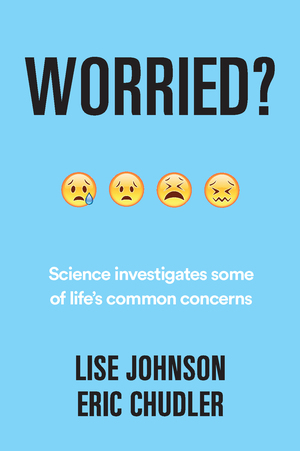It’s been 30 years since Bobby McFerrin urged us, “Don’t Worry, Be Happy.” But it’s not so easy, is it? In the modern world, there’s plenty that you could worry about — but what should you worry about? If you worry about everything, you end up paralyzed with fear; if, on the other hand, you never worry about anything, you’re likely to end up falling victim to circumstances that you could have prevented.

BOOK REVIEW — “Worried? Science investigates some of life’s common concerns,” by Lise Johnson and Eric Chudler (W.W. Norton, 312 pages).
Lise Johnson and Eric Chudler have written a new book to help you navigate the worrysphere. Johnson is a biomedical engineer and a science writer and Chudler is a neuroscientist, and together they lead us on a tour of 58 things that one might potentially worry about, and try to assess how much those things are actually worth worrying about. The authors shine a spotlight on everything from caffeine, fluoride, and the Ebola virus to bees, snakes, public restrooms, and cruise ships.
If it were only a list, I suspect they’d have had trouble getting a book deal — but fortunately it’s more than that. The authors have found a nifty way of presenting the variables in graphic form (what they call a “worry index”), displaying each worry-item as a circle on a Cartesian graph: Likelihood is plotted on the x-axis, and preventability on the y-axis; meanwhile, the size of the circle reflects the consequences, or the severity, of the issue. For example, a flesh-eating infection gets a pretty big circle — the disease can be fatal if left untreated. Fortunately, your chances of getting it are very low, so the circle is placed on the far left-hand-side of the graph; and it’s also highly preventable (with good hygiene and prompt medical treatment), so the circle sits high up on the y-axis. In contrast, although “medical errors” get a similar-sized circle, it falls in the lower-right quadrant: Doctors and nurses make mistakes more often than we might imagine, and there’s not much you can do to prevent such errors from happening.
So what’s the bottom line? The authors are very up front regarding their philosophy: We should only worry about things that are likely to happen, and which are likely to cause serious harm if they do happen — and which you can take reasonable measures to prevent from happening. In other words, only worry about the large circles positioned in the upper-right quadrant. And — surprise! — these turn out to be the same things your doctor has been warning you about all these years, with sugar and alcohol leading the way (with lead, mercury, and mosquitos next in line).
There is no jargon; indeed, the pages positively ooze with both common sense and straightforward truths: “Encounters with bears can be prevented by avoiding places frequented by bears”; “It is unlikely that an amoeba will eat your brain.” The chapter on gluten ends by noting that those on a gluten-free diet may need to make up for a lack of fiber and vitamins, so if you decide to go gluten-free, “you need to be eating beans, lentils, wild rice, unsalted nuts, sweet potatoes, green veggies, and fruits. Actually, that’s what we should all be eating anyway, gluten free or not.”
Meanwhile, those items in the lower-left quadrant can be safely ignored: Regardless of how much harm they might do, they’re unlikely to happen and there’s not much you can do to prevent them anyway. An asteroid hit is the quintessential example. (It is worth mentioning, however, that although we might not worry about asteroids very much as individuals, NASA does in fact worry about them, given the enormous stakes.)
“Worried?” is an easy read — the chapters are very short — but I’m worried (sorry) that something’s missing. The problem is that there’s no way to catalog all the different things that people might worry about (the authors recognize this, saying it would be “an impossible task”). So, for example, while there’s a section on airport body scanners, there’s nothing about turbulence, hijacking, or airline safety more generally.
OK, they can’t cram everything in. But it’s not just that. The book omits some of our most seemingly urgent fears. Topping the list would be global climate change: the authors say they’ve intentionally left this out, along with vaccines, because “they have been so frequently and thoroughly covered elsewhere.” They also omit nuclear war because it is “beyond the scope” of the book. (Wouldn’t this book have been a great place to point out that vaccines are generally safe, and that climate change is a pretty big deal?) And what about cyber-crime, identity theft, Russian bots, and the like? Or road traffic crashes, which kill approximately 1.35 million people worldwide each year?
As a journalist, I also wonder why the various “headline worries” — the fears that tabloid newspapers and cable news channels seem to nurture — are absent. Those on the right are told to fear immigration, crime, terrorism, and creeping socialism; those on the left fear an erosion of civil rights and creeping fascism. I don’t mean to suggest there’s a perfect symmetry between the two sides; research has shown that the attitudes of conservatives, in particular, are strongly fear-driven. (As I was writing this review, Donald Trump claimed that noise from wind turbines causes cancer. They don’t — but no doubt it will spark fear in at least some people.)
None of these kinds of fears (or the politics that surrounds them) are mentioned in the book; indeed, of the 58 items, the only one that involves crime is “pirates” — which, we’re told, is highly preventable (“Stay out of dangerous waters”) and also unlikely (“Few people will encounter pirates on the open seas”). I’m not sure how the authors could have added more crimes without changing the flavor of the book entirely; still, it’s an odd omission. (Raise your hand if you’ve never worried about your safety while riding the subway late at night.)
I admire the authors for laying out a reasonable quantification scheme for our worries; there’s even an appendix in which readers are encouraged to work out worry-factors for themselves, for items not covered in the book. And I absolutely agree with their suggestion that we ought to focus on those cases in which likelihood, preventability, and severity of consequences intersect. It’s just that there are so many more things that we could worry about. Books are finite, but our fears are boundless.
Dan Falk (@danfalk) is a science journalist based in Toronto. His books include The Science of Shakespeare and In Search of Time.











Comments are automatically closed one year after article publication. Archived comments are below.
All very nice. But who will tell me HOW to stop worrying?
Sounds like an interesting read! I will have to pick up a copy soon
Seems a case of ” Think Fear..& attract Fear ” ..Fear that stays, the trouble..” Main thing is not to dwell upon Fears..To stop worrying so much & use mental discipline & also Faith to Stop welling up the Fears ..Fears thst may never happen, included..